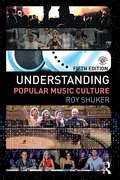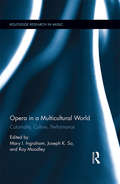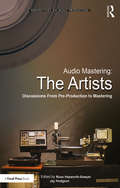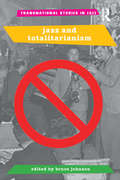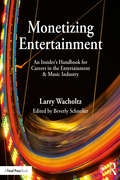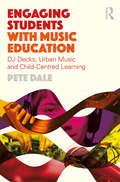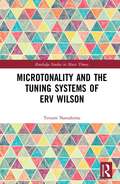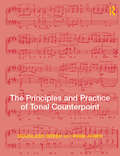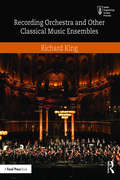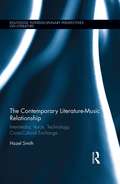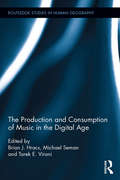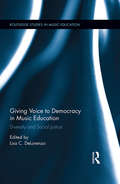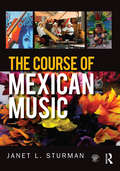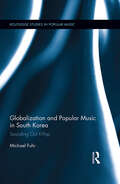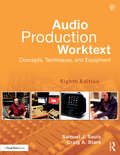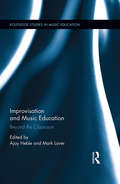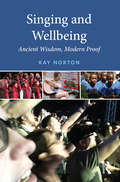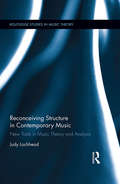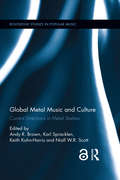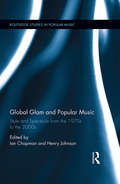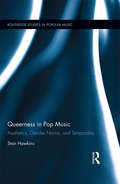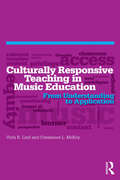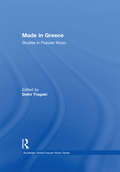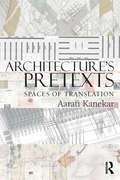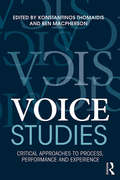- Table View
- List View
Understanding Popular Music Culture
by Roy ShukerThis extensively revised and expanded fifth edition of Understanding Popular Music Culture provides an accessible and comprehensive introduction to the production, distribution, consumption and meaning of popular music, and the debates that surround popular culture and popular music. Reflecting the continued proliferation of popular music studies, the new music industry in a digital age, and the emergence of new stars, this new edition has been reorganized and extensively updated throughout, making for a more coherent and sequenced coverage of the field. These updates include: two new chapters entitled 'The Real Thing': Authenticity, covers and the canon and 'Time Will Pass You By': Histories and popular memory new case studies on artists including The Rolling Stones, Lorde, One Direction and Taylor Swift further examples of musical texts, genres, and performers throughout including additional coverage of Electronic Dance Music expanded coverage on the importance of the back catalogue and the box set; reality television and the music biopic greater attention to the role and impact of the internet and digital developments in relation to production, dissemination, mediation and consumption; including the role of social network sites and streaming services each chapter now has its own set of expanded references to facilitate further investigation. Additional resources for students and teachers can also be found on the companion website (www.routledge.com/cw/shuker), which includes additional case studies, links to relevant websites and a discography of popular music metagenres.
Opera in a Multicultural World: Coloniality, Culture, Performance (Routledge Research in Music)
by Roy Moodley Mary Ingraham Joseph SoThrough historical and contemporary examples, this book critically explores the relevance and expressions of multicultural representation in western European operatic genres in the modern world. It reveals their approaches to reflecting identity, transmitting meaning, and inspiring creation, as well as the ambiguities and contradictions that occur across the time and place(s) of their performance. This collection brings academic researchers in opera studies into conversation with previously unheard voices of performers, critics, and creators to speak to issues of race, ethnicity, and culture in the genre. Together, they deliver a powerful critique of the perpetuation of the values and practices of dominant cultures in operatic representations of intercultural encounters. Essays accordingly cross methodological boundaries in order to focus on a central issue in the emerging field of coloniality: the hierarchies of social and political power that include the legacy of racialized practices. In theorizing coloniality through intercultural exchange in opera, authors explore a range of topics and case studies that involve immigrant, indigenous, exoticist, and other cultural representations and consider a broad repertoire that includes lesser-known Canadian operas, Chinese- and African-American performances, as well as works by Haydn, Strauss, Puccini, and Wagner, and in performances spanning three continents and over two centuries. In these ways, the collection contributes to the development of a more integrated understanding of the interdisciplinary fields inherent in opera, including musicology, sociology, anthropology, and others connected to Theatre, Gender, and Cultural Studies.
Audio Mastering: Discussions from Pre-Production to Mastering (Perspectives on Music Production)
by Russ Hepworth-Sawyer Jay HodgsonAudio Mastering: The Artists collects more than twenty interviews, drawn from more than 60 hours of discussions, with many of the world’s leading mastering engineers. In these exclusive and often intimate interviews, engineers consider the audio mastering process as they, themselves, experience and shape it as the leading artists in their field. Each interview covers how engineers got started in the recording industry, what prompted them to pursue mastering, how they learned about the process, which tools and techniques they routinely use when they work, and a host of other particulars of their crafts. We also spoke with mix engineers, and craftsmen responsible for some of the more iconic mastering tools now on the market, to gain a broader perspective on their work. This book is the first to provide such a comprehensive overview of the audio mastering process told from the point-of-view of the artists who engage in it. In so doing, it pulls the curtain back on a crucial, but seldom heard from, agency in record production at large.
Jazz and Totalitarianism
by Bruce JohnsonJazz and Totalitarianism examines jazz in a range of regimes that in significant ways may be described as totalitarian, historically covering the period from the Franco regime in Spain beginning in the 1930s to present day Iran and China. The book presents an overview of the two central terms and their development since their contemporaneous appearance in cultural and historiographical discourses in the early twentieth century, comprising fifteen essays written by specialists on particular regimes situated in a wide variety of time periods and places. Interdisciplinary in nature, this compelling work will appeal to students from Music and Jazz Studies to Political Science, Sociology, and Cultural Theory.
Monetizing Entertainment: An Insider's Handbook for Careers in the Entertainment and Music Industry
by Larry Wacholtz<p><i>Monetizing Entertainment: An Insider's Handbook for Careers in the Entertainment and Music Industry</i> offers a thorough, guided exploration of the current state of the industry, with an emphasis on trends in copyright, digital streaming, and practical advice for developing a career as an artist, technician, or industry executive. <p>This book investigates a variety of topics within the entertainment and music industry, ranging from traditional and emerging business models to intellectual property rights to the creative destruction happening currently. The book strategically outlines the existing gaps that make being successful as an artist a dynamic interaction between creativity and business. <p>This book includes the following: <p> <li>An overview of the creative destruction process that has destroyed some of the old business models and created a number of career options. <li>A look at innovative, entrepreneurial career options. <li>A step-by-step examination for both creative and business professionals of the administrative and financial structures of the industry. <li>Detailed analysis of trends and topics shaping the current entertainment and music industry drawn from insiders' perspectives and other contemporary resources.</li> <p> <p>An accompanying website (www.routledge.com/cw/wacholtz), hosting case studies, videos, data, infographics, and blog posts on business models, is the perfect companion to this authoritative resource.</p>
Engaging Students with Music Education: DJ decks, urban music and child-centred learning
by Pete DaleEngaging Students with Music Education is a groundbreaking book about using DJ decks and urban music in mainstream schools to re-engage disaffected learners and develop a curriculum which better reflects overall contemporary tastes. Many young learners are ‘at risk’ of exclusion; this book argues that for such individuals, the implications of such a shift in the music curriculum could be especially positive. Drawing extensively on the author’s own wealth of teaching experience, and bridging the gap between practice and theory, this book demonstrates through case studies that DJ decks can prove extremely valuable in mainstream classroom situations across the secondary school age ranges. Addressing challenging and crucial topics, combining rigorous theoretical analysis with practical suggestions, the book addresses questions such as: Are DJ decks actually a musical instrument, and are they suitable for classroom teaching? Will Ofsted's school inspectors approve of music teaching involving DJ decks and urban music? If we bring urban music into the classroom, will this further marginalise classical music? Are DJing and MCing skills recognised within examination specifications, at least in the UK? Current teachers will find the practical advice on how to incorporate DJ decks and urban music into their classroom especially helpful, whilst educational researchers will be captivated by the critical discussion of the child-centred tradition and a theoretical approach which stretches from ‘continental’ philosophy to practice-based reflection. With an insistence that the starting point for music education should always be the interests and experiences of the learners, this book is essential reading for those music teachers and researchers interested in the benefits of non-standard music-making in the classroom.
Microtonality and the Tuning Systems of Erv Wilson: Mapping the Harmonic Spectrum (Routledge Studies in Music Theory)
by Terumi NarushimaThis book explores the emerging area of microtonality through an examination of the tuning theories of Erv Wilson. It is the first publication to offer a broad discussion of this influential theorist whose innovations have far-reaching ramifications for microtonal tuning systems. This study addresses the breadth and complexity of Wilson’s work by focusing on his microtonal keyboard designs as a means to investigate his tuning concepts and their practical applications. Narushima examines materials ranging from historical and experimental tunings to instrument design, as well as musical applications of mathematical theories and multidimensional geometry. The volume provides an analysis of some of Wilson’s most significant theoretical ideas, including the Scale Tree, Moments of Symmetry, Constant Structures, and Combination-Product Sets. These theories offer ways to conceptualize musical scales as patterns with structural integrity and whose shapes can be altered to produce infinitely varying forms. The book shows how these structural properties can be used to map scales onto a microtonal keyboard by providing step-by-step guidelines and clearly illustrated examples. Most importantly, it brings together theoretical and practical methods of tuning to enable composers, performers, and instrument designers to explore previously uncharted areas of microtonality, making a significant contribution to the fields of music theory, composition and music technology.
The Principles and Practice of Tonal Counterpoint
by Evan JonesThe Principles and Practice of Tonal Counterpoint is a comprehensive textbook that combines practical, "how-to" guidance in 18th-century techniques with extensive historical examination of contrapuntal works and genres. Beginning with an introductory grounding in species counterpoint, tonal harmony, and figured bass, students progress through the study of chorale preludes, invertible counterpoint, and canonic and fugal writing. This textbook thoroughly joins principle with practice, providing a truly immersive experience in the study of tonal counterpoint and familiarizing students with contrapuntal styles from the Baroque period to the 21st century. Also available is a companion volume, The Principles and Practice of Modal Counterpoint, which focuses on 16th-century techniques and covers modal music from Gregorian chant through the 17th century.
Recording Orchestra and Other Classical Music Ensembles (Audio Engineering Society Presents)
by Richard KingRecording Orchestra and Other Classical Music Ensembles explores techniques and methodologies specific to recording classical music. Whether a newcomer or a seasoned engineer looking to refine their skills, this book speaks to all levels of expertise and covers every aspect of recording symphonic and concerto repertoire, opera, chamber music, and solo piano. With a focus on the orchestra as an instrument and sound source, this book features sections on how to listen, understanding microphones, concert halls, orchestra seating arrangements, how to set up the monitoring environment, and how to approach recording each section of the orchestra. Recording Orchestra provides concise information on preparing for a recording session, the role of the producer, mixing techniques, and includes a "quick-start" reference guide with suggested setups aimed at helping introduce the reader to the recording process. A companion website, featuring audio examples of various techniques, reinforces concepts discussed throughout the book. The content of the book includes: Clear, practical advice in plain language from an expert in classical music recording, multiple Grammy award winning recording engineer, and university professor The "secret of recording": a collection of practical recording techniques that have been proven to be highly successful in the field, on many occasions Never before published information written by an industry veteran with over twenty five-years of experience in classical music recording Specific techniques and strategies for recording orchestra, opera, wind symphony, chorus, string quartet, and other common classical music ensembles.
The Contemporary Literature-Music Relationship: Intermedia, Voice, Technology, Cross-Cultural Exchange (Routledge Interdisciplinary Perspectives on Literature)
by Hazel SmithThis book explores the relationship between words and music in contemporary texts, examining, in particular, the way that new technologies are changing the literature-music relationship. It brings an eclectic and novel range of interdisciplinary theories to the area of musico-literary studies, drawing from the fields of semiotics, disability studies, musicology, psychoanalysis, music psychology, emotion and affect theory, new media, cosmopolitanism, globalization, ethnicity and biraciality. Chapters range from critical analyses of the representation of music and the musical profession in contemporary novels to examination of the forms and cultural meanings of contemporary intermedia and multimedia works. The book argues that conjunctions between words and music create emergent structures and meanings that can facilitate culturally transgressive and boundary- interrogating effects. In particular, it conceptualises ways in which word-music relationships can facilitate cross-cultural exchange as musico-literary miscegenation, using interracial sexual relationships as a metaphor. Smith also inspects the dynamics of improvisation and composition, and the different ways they intersect with performance. Furthermore, the book explores the huge changes that computer-based real-time algorithmic text and music generation are making to the literature-music nexus. This volume provides fascinating insight into the relationship between literature and music, and will be of interest to those fields as well as New Media and Performance Studies.
The Production and Consumption of Music in the Digital Age (Routledge Studies in Human Geography #58)
by Tarek E. Virani Brian J. Hracs Michael SemanThe economic geography of music is evolving as new digital technologies, organizational forms, market dynamics and consumer behavior continue to restructure the industry. This book is an international collection of case studies examining the spatial dynamics of today’s music industry. Drawing on research from a diverse range of cities such as Santiago, Toronto, Paris, New York, Amsterdam, London, and Berlin, this volume helps readers understand how the production and consumption of music is changing at multiple scales – from global firms to local entrepreneurs; and, in multiple settings – from established clusters to burgeoning scenes. The volume is divided into interrelated sections and offers an engaging and immersive look at today’s central players, processes, and spaces of music production and consumption. Academic students and researchers across the social sciences, including human geography, sociology, economics, and cultural studies, will find this volume helpful in answering questions about how and where music is financed, produced, marketed, distributed, curated and consumed in the digital age.
Giving Voice to Democracy in Music Education: Diversity and Social Justice in the Classroom (Routledge Studies in Music Education)
by Lisa C. DeLorenzoThis book examines how music education presents opportunities to shape democratic awareness through political, pedagogical, and humanistic perspectives. Focusing on democracy as a vital dimension in teaching music, the essays in this volume have particular relevance to teaching music as democratic practice in both public schooling and in teacher education. Although music educators have much to learn from others in the educational field, the actual teaching of music involves social and political dimensions unique to the arts. In addition, teaching music as democratic practice demands a pedagogical foundation not often examined in the general teacher education community. Essays include the teaching of the arts as a critical response to democratic participation; exploring democracy in the music classroom with such issues as safe spaces, sexual orientation, music of the Holocaust, improvisation, race and technology; and music teaching/music teacher education as a form of social justice. Engaging with current scholarship, the book not only probes the philosophical nature of music and democracy, but also presents ways of democratizing music curriculum and human interactions within the classroom. This volume offers the collective wisdom of international scholars, teachers, and teacher educators and will be essential reading for those who teach music as a vital force for change and social justice in both local and global contexts.
The Course of Mexican Music
by Janet SturmanThe Course of Mexican Music provides students with a cohesive introductory understanding of the scope and influence of Mexican music. The textbook highlights individual musical examples as a means of exploring the processes of selection that led to specific musical styles in different times and places, with a supporting companion website with audio and video tracks helping to reinforce readers' understanding of key concepts. The aim is for students to learn an exemplary body of music as a window for understanding Mexican music, history and culture in a manner that reveals its importance well beyond the borders of that nation.
Globalization and Popular Music in South Korea: Sounding Out K-Pop (Routledge Studies in Popular Music)
by Michael FuhrThis book offers an in-depth study of the globalization of contemporary South Korean idol pop music, or K-Pop, visiting K-Pop and its multiple intersections with political, economic, and cultural formations and transformations. It provides detailed insights into the transformative process in and around the field of Korean pop music since the 1990s, which paved the way for the recent international rise of K-Pop and the Korean Wave. Fuhr examines the conditions and effects of transnational flows, asymmetrical power relations, and the role of the imaginary "other" in K-Pop production and consumption, relating them to the specific aesthetic dimensions and material conditions of K-Pop stars, songs, and videos. Further, the book reveals how K-Pop is deployed for strategies of national identity construction in connection with Korean cultural politics, with transnational music production circuits, and with the transnational mobility of immigrant pop idols. The volume argues that K-Pop is a highly productive cultural arena in which South Korea’s globalizing and nationalizing forces and imaginations coincide, intermingle, and counteract with each other and in which the tension between both of these poles is played out musically, visually, and discursively. This book examines a vibrant example of contemporary popular music from the non-Anglophone world and provides deeper insight into the structure of popular music and the dynamics of cultural globalization through a combined set of ethnographic, musicological, and cultural analysis. Widening the regional scope of Western-dominated popular music studies and enhancing new areas of ethnomusicology, anthropology, and cultural studies, this book will also be of interest to those studying East Asian popular culture, music globalization, and popular music.
Audio Production Worktext: Concepts, Techniques, and Equipment
by Samuel J. Sauls Craig A. StarkThis is an excellent introduction to the modern radio production studio, the equipment found in that studio, and the basic techniques needed to accomplish radio production work. The new edition is updated throughout and features new sections on mobile technology, audio editing apps and software, and digital editing, as well as updated graphics and expanded content on portable digital audio players. Features a worktext/website format tailored for both students and teachers, offering a solid foundation for anyone who wishes to know more about radio/audio equipment and production techniques.
Improvisation and Music Education: Beyond the Classroom (Routledge Studies in Music Education)
by Ajay Heble Mark LaverThis book offers compelling new perspectives on the revolutionary potential of improvisation pedagogy. Bringing together contributions from leading musicians, scholars, and teachers from around the world, the volume articulates how improvisation can breathe new life into old curricula; how it can help teachers and students to communicate more effectively; how it can break down damaging ideological boundaries between classrooms and communities; and how it can help students become more thoughtful, engaged, and activist global citizens. In the last two decades, a growing number of music educators, music education researchers, musicologists, cultural theorists, creative practitioners, and ethnomusicologists have suggested that a greater emphasis on improvisation in music performance, history, and theory classes offers enormous potential for pedagogical enrichment. This book will help educators realize that potential by exploring improvisation along a variety of trajectories. Essays offer readers both theoretical explorations of improvisation and music education from a wide array of vantage points, and practical explanations of how the theory can be implemented in real situations in communities and classrooms. It will therefore be of interest to teachers and students in numerous modes of pedagogy and fields of study, as well as students and faculty in the academic fields of music education, jazz studies, ethnomusicology, musicology, cultural studies, and popular culture studies.
Singing and Wellbeing: Ancient Wisdom, Modern Proof
by Kay NortonSinging and Wellbeing provides evidence that the benefits of a melodious voice go far beyond pleasure, and confirms the importance of singing in optimum health. A largely untapped resource in the health care professions, the singing voice offers rewards that are closer than ever to being fully quantified by advances in neuroscience and psychology. For music, pre-med, bioethics, and medical humanities students, this book introduces the types of ongoing research that connect behaviour and brain function with the musical voice.
Reconceiving Structure in Contemporary Music: New Tools in Music Theory and Analysis (Routledge Studies in Music Theory)
by Judy LochheadThis book studies recent music in the western classical tradition, offering a critique of current analytical/theoretical approaches and proposing alternatives. The critique addresses the present fringe status of recent music sometimes described as crossover, postmodern, post-classical, post-minimalist, etc. and demonstrates that existing descriptive languages and analytical approaches do not provide adequate tools to address this music in positive and productive terms. Existing tools and concepts were developed primarily in the mid-20th century in tandem with the high modernist compositional aesthetic, and they have changed little since then. The aesthetics of music composition, on the other hand, have been in constant transformation. Lochhead proposes new ways to conceive musical works, their structurings of musical experience and time, and the procedures and goals of analytic close reading. These tools define investigative procedures that engage the multiple perspectives of composers, performers, and listeners, and that generate conceptual modes unique to each work. In action, they rebuild a conceptual, methodological, and experiential place for recent music. These new approaches are demonstrated in analyses of four pieces: Kaija Saariaho’s Lonh (1996), Sofia Gubaidulina’s Second String Quartet (1987), Stacy Garrop’s String Quartet no.2, Demons and Angels (2004-05), and Anna Clyne’s "Choke" (2004). This book defies the prediction of classical music’s death, and will be of interest to scholars and musicians of classical music, and those interested in music theory, musicology, and aural culture.
Global Metal Music and Culture: Current Directions in Metal Studies (Routledge Studies in Popular Music)
by Keith Kahn-Harris Karl Spracklen Niall Scott Andy R. BrownThis book defines the key ideas, scholarly debates, and research activities that have contributed to the formation of the international and interdisciplinary field of Metal Studies. Drawing on insights from a wide range of disciplines including popular music, cultural studies, sociology, anthropology, philosophy, and ethics, this volume offers new and innovative research on metal musicology, global/local scenes studies, fandom, gender and metal identity, metal media, and commerce. Offering a wide-ranging focus on bands, scenes, periods, and sounds, contributors explore topics such as the riff-based song writing of classic heavy metal bands and their modern equivalents, and the musical-aesthetics of Grindcore, Doom metal, Death metal, and Progressive metal. They interrogate production technologies, sound engineering, album artwork and band promotion, logos and merchandising, t-shirt and jewellery design, and fan communities that define the global metal music economy and subcultural scene. The volume explores how the new academic discipline of metal studies was formed, also looking forward to the future of metal music and its relationship to metal scholarship and fandom. With an international range of contributors, this volume will appeal to scholars of popular music, cultural studies, and sociology, as well as those interested in metal communities around the world.
Global Glam and Popular Music: Style and Spectacle from the 1970s to the 2000s (Routledge Studies in Popular Music)
by Henry Johnson Ian ChapmanThis book is the first to explore style and spectacle in glam popular music performance from the 1970s to the present day, and from an international perspective. Focus is given to a number of representative artists, bands, and movements, as well as national, regional, and cultural contexts from around the globe. Approaching glam music performance and style broadly, and using the glam/glitter rock genre of the early 1970s as a foundation for case studies and comparisons, the volume engages with subjects that help in defining the glam phenomenon in its many manifestations and contexts. Glam rock, in its original, term-defining inception, had its birth in the UK in 1970/71, and featured at its forefront acts such as David Bowie, T. Rex, Slade, and Roxy Music. Termed "glitter rock" in the US, stateside artists included Alice Cooper, Suzi Quatro, The New York Dolls, and Kiss. In a global context, glam is represented in many other cultures, where the influences of early glam rock can be seen clearly. In this book, glam exists at the intersections of glam rock and other styles (e.g., punk, metal, disco, goth). Its performers are characterized by their flamboyant and theatrical appearance (clothes, costumes, makeup, hairstyles), they often challenge gender stereotypes and sexuality (androgyny), and they create spectacle in popular music performance, fandom, and fashion. The essays in this collection comprise theoretically-informed contributions that address the diversity of the world’s popular music via artists, bands, and movements, with special attention given to the ways glam has been influential not only as a music genre, but also in fashion, design, and other visual culture.
Queerness in Pop Music: Aesthetics, Gender Norms, and Temporality (Routledge Studies in Popular Music #10)
by Stan HawkinsThis book investigates the phenomenon of queering in popular music and video, interpreting the music of numerous pop artists, styles, and idioms. The focus falls on artists, such as Lady Gaga, Madonna, Boy George, Diana Ross, Rufus Wainwright, David Bowie, Azealia Banks, Zebra Katz, Freddie Mercury, the Pet Shop Boys, George Michael, and many others. Hawkins builds his concept of queerness upon existing theories of opacity and temporality, which involves a creative interdisciplinary approach to musical interpretation. He advocates a model of analysis that involves both temporal-specific listening and biographic-oriented viewing. Music analysis is woven into this, illuminating aspects of parody, nostalgia, camp, naivety, masquerade, irony, and mimesis in pop music. One of the principal aims is to uncover the subversive strategies of pop artists through a wide range of audiovisual texts that situate the debates on gender and sexuality within an aesthetic context that is highly stylized and ritualized. Queerness in Pop Music also addresses the playfulness of much pop music, offering insights into how discourses of resistance are mediated through pleasure. Given that pop artists, songwriters, producers, directors, choreographers, and engineers all contribute to the final composite of the pop recording, it is argued that the staging of any pop act is a collective project. The implications of this are addressed through structures of gender, ethnicity, nationality, class, and sexuality. Ultimately, Hawkins contends that queerness is a performative force that connotes futurity and utopian promise.
Culturally Responsive Teaching in Music Education: From Understanding to Application
by Vicki R. Lind Constance McKoyCulturally Responsive Teaching in Music Education presents teaching methods that are responsive to how different culturally specific knowledge bases impact learning. It is a pedagogy that recognizes the importance of including students’ cultural references in all aspects of learning. Designed to be a supplementary resource for teachers of undergraduate and graduate music education courses, the book provides examples in the context of music education, with theories presented in Section I and a review of teaching applications in Section II. Culturally Responsive Teaching in Music Education is an effort to answer the question: How can I teach music to my students in a way that is culturally responsive? This book serves several purposes, by: • Offering theoretical/philosophical frameworks of social justice • Providing practical examples of transferring theory into practice in music education • Illustrating culturally responsive pedagogy within the classroom • Demonstrating the connection of culturally responsive teaching to the school and larger community
Made in Greece: Studies in Popular Music (Routledge Global Popular Music Series)
by Dafni TragakiMade in Greece: Studies in Popular Music serves as a comprehensive and thorough introduction to the history, sociology, and musicology of contemporary Greek popular music. Each essay covers the major figures, styles, and social contexts of pop music in Greece, first presenting a general description of the history and background of popular music in Greece, followed by essays, written by leading scholars of Greek music, that are organized into thematic sections: Hugely Popular, Art-song Trajectories, Greekness beyond Greekness, Counter Stories, and Present Musical Pasts.
Architecture's Pretexts: Spaces of Translation
by Aarati KanekarThe aim of this book is to expose readers to architecture’s pretexts that include literary narratives, film, theatre, painting, music, and ritual, as a bridge between diverse intellectual territories and architecture. It introduces a selection of seminal modern and contemporary architectural projects, their situation within the built environment, and their intellectual and formal situation/context as pretexts and design paradigms. Connections between diverse bodies of information will be cultivated along with the ability to posit consequential relationships for the production of architecture. Architecture’s Pretexts seeks to cultivate a vision for architecture that sponsors operative links between the discipline of architecture and those outside of architecture. Exploring the works of various architects including Guiseppe Terragni, Peter Eisenman, Peter Zumthor, Perry Kulper and Smout Allen, and Rem Koolhaas, this book provides the framework to understanding architecture through the lens of art. Key concepts discussed are: allegories, diagrams, form, material, montage, movement, musical ratios, narrative sequence and representation. A valuable tool, with over 75 black and white illustrations, for students and professionals interested in interdisciplinary methods of design thinking.
Voice Studies: Critical Approaches to Process, Performance and Experience (Routledge Voice Studies)
by Konstantinos Thomaidis Ben MacphersonVoice Studies brings together leading international scholars and practitioners, to re-examine what voice is, what voice does, and what we mean by "voice studies" in the process and experience of performance. This dynamic and interdisciplinary publication draws on a broad range of approaches, from composing and voice teaching through to psychoanalysis and philosophy, including: voice training from the Alexander Technique to practice-as-research; operatic and extended voices in early baroque and contemporary underwater singing; voices across cultures, from site-specific choral performance in Kentish mines and Australian sound art, to the laments of Kraho Indians, Korean pansori and Javanese wayang; voice, embodiment and gender in Robertson’s 1798 production of Phantasmagoria, Cathy Berberian radio show, and Romeo Castellucci’s theatre; perceiving voice as a composer, listener, or as eavesdropper; voice, technology and mobile apps. With contributions spanning six continents, the volume considers the processes of teaching or writing for voice, the performance of voice in theatre, live art, music, and on recordings, and the experience of voice in acoustic perception and research. It concludes with a multifaceted series of short provocations that simply revisit the core question of the whole volume: what is voice studies?
